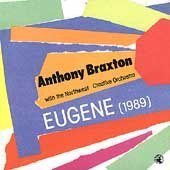| All Artists: Anthony Braxton, Northwest Creative Orchestra Title: Eugene Members Wishing: 3 Total Copies: 0 Label: Black Saint Release Date: 9/8/1993 Genres: Jazz, Special Interest, Pop Styles: Avant Garde & Free Jazz, Swing Jazz, Experimental Music Number of Discs: 1 SwapaCD Credits: 1 UPC: 027312013726 |
Search - Anthony Braxton, Northwest Creative Orchestra :: Eugene
 | Anthony Braxton, Northwest Creative Orchestra Eugene Genres: Jazz, Special Interest, Pop
|
Larger Image |
CD Details |
CD ReviewsCreative music for a big band N. Dorward | Toronto, ON Canada | 08/12/2001 (4 out of 5 stars) "This disc documents a 1989 concert in Eugene, Oregon by the Northwest Creative Orchestra, as conducted by Braxton himself (who also contributes a little alto sax too). The 17-piece band doesn't have any famous musicians in it--indeed, the only names I recognized besides Braxton's were those of the trumpeter Rob Blakeslee & the trombonist Mike Heffley (who wrote a so-so book on Braxton's music)--but they acquit themselves very well. The instrumentation is unusual among Braxton's large-scale projects in the presence of guitar & synthesizer.The music runs the gamut from fairly straightahead jazz to highly abstract composition. Composition 112 is a mid-tempo swing piece that strongly suggests Eric Dolphy's work through its angular melody & its use of vibes--it bears comparison with Dolphy's _Iron Man_ date. Composition 134 is an exercise in the overlay of interlocking ostinati: the effect is like hearing a roomful of metronomes carefully calibrated but at different speeds. Somehow Braxton's "title"--an image of a man and woman on the top of a building overlooking a cityscape, while a red biplane comes in to land on the rooftop--is exactly appropriate. Composition 100, by the sharpest of contrasts, is entirely outside the jazz idiom: it's an exercise in the quietly shifting expansion & contraction of the musical space, each insturment playing a different line: eventually after a series of irregular gatherings & dispersals of voices, there's a long silence, & a more unified passage concludes the piece. Composition 45 (the earliest piece on this disc) starts with a lumbering 6/4 motif rather like a march, then suddenly shifts to a continuous sound-space with fluttering reeds & interjections from the drums & tympani; a drum solo leads to a series of tumbling fanfares; then a vibes solo over mournful brass; & then the initial march resumes, newly energized, to take centre stage--there's a remarkable, splenetic tenor solo here over the orchestra's clangorous supporting chords. It gets a rise out of the audience, only to undo itself into delicate near-silence for an arco bass solo that forms the bridge to the next track (Composition 71, which works off a a sinuous 4/4 groove).Not an easy listen, though those who've listened to much Braxton will be familiar enough with the vocabulary: dissonant, angular, & yet a convincing outgrowth of the entire jazz tradition. The feeling here is a lot "cooler" than on Braxton's small-group discs, in part because of the instrumentation (the vibes in particular), in part because Braxton's scorching alto isn't featured extensively. Yet the disc is compelling & rewards the attention: congratulations to all these players for putting themselves at the service of some very difficult music & pulling it off."
|

 Track Listings (8) - Disc #1
Track Listings (8) - Disc #1